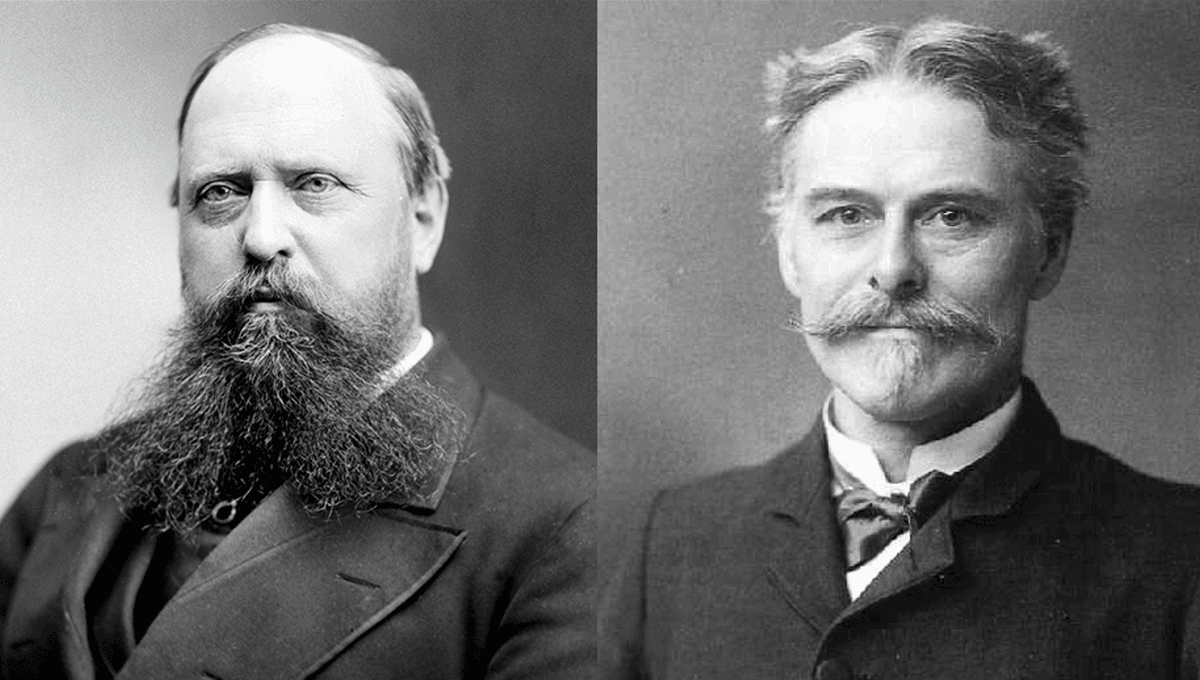
In the 19th century, the discovery of dinosaurs fuelled one of the most heated and ridiculous conflicts ever seen between two scientists. While both bone-hunters were ultimately ruined by their bitter rivalry, their work discovered over 100 species of dinosaurs – like Stegosaurus, Brontosaurus, and Triceratops – and helped to lay the groundwork for our current understanding of dinosaurs.
The Bone Wars revolved around the competition between Edward Drinker Cope and Othniel Charles Marsh in their quests to find and name the most dinosaur fossils in the American West towards the end of the 19th century. As part of the ego-fuelled effort to get their name in the history books, the pair resorted to a campaign of dirty tactics to undermine each other, including bribery, spying, theft, and the destruction of bones.
Their relationship wasn’t always hostile, however. The pair first met in the early 1860s while studying paleontology in Germany, where they appeared to enjoy a perfectly pleasant friendship. They even named some of their newly described species after each other. After Cope named an amphibian fossil Ptyonius marshii in honour of Marsh, he returned the favor by naming an extinct marine reptile Mosasaurus copeanus.
Things turned sour when they both returned to the US. In 1868, Cope gave Marsh a tour of a fossil quarry in Haddonfield, New Jersey. Behind Cope’s back, Marsh paid off the quarry owner to send any new fossil discoveries to his offices at the Peabody Museum of Natural History at Yale, which was founded by Marsh’s wealthy uncle, George Peabody (wonder how he got that job).
Another nail in the coffin of this friendship occurred in 1868 when Cope published a study on a newly discovered extinct marine reptile, Elasmosaurus platyurus. Rather embarrassingly, he had totally misunderstood the anatomy of the animal and effectively placed the skull at the end of its tail.
After Marsh pointed out the blunder, Cope tried to purchase all known copies of the American Philosophical Society journal with the error. However, it was too late. Marsh later wrote: “When I informed Professor Cope of it, his wounded vanity received a shock from which it has never recovered, and he has since been my bitter enemy.”
With the advent of the transcontinental railroad, the American West was opened up, providing Marsh and Cope with the perfect playground for their work. The pair separately unearthed and described a number of important paleontological discoveries at this time and rushed to get them published in scientific journals, hoping to one-up each other.
Marsh would often throw cold water on Cope’s papers, claiming they revealed nothing new or weren’t anything special. To gain the upper hand in the rush to publish papers, Cope even brought the American Naturalist journal.
Tensions reached their apex in 1877 when railroad workers discovered dinosaur fossils in Como Bluff located near the town of Medicine Bow, Wyoming. It quickly became apparent that the site was loaded with incredibly well-preserved fossils of many, many dinosaurs.
Marsh was informed of the discovery and promptly sent an army of diggers to investigate. By December 1877, Marsh had described and named a number of dinosaurs at the site, including such as Stegosaurus, Allosaurus, and Apatosaurus.
However, Cope had also caught wind of the news, upon which he sent his own men to the area and set up his own quarry. The camps were just a bone’s throw away from one another, bringing the rival crews into close proximity.
Along with reports of fistfights and rocks being thrown at between the parties, people were accused of spying on behalf of the other camps. Cope even accused Marsh of smashing up the remaining hints of fossils to prevent the rival team from recovering any information, while Marsh accused him of trespassing.
If anyone can claim they won the Bone Wars, it would arguably be Marsh. Cope fell on hard times and squandered much of his money on silver mines in New Mexico that eventually went bust. Meanwhile, Marsh was awarded the position of lead Vertebrate Paleontologist of the US Geological Survey.
In the end, however, both died broke and alone with a somewhat dubious legacy. Their egotistical pursuit for glory ended up revealing a ton of important insights into dinosaurs and extant reptiles, but their childish antics weren’t great PR for the emerging field of paleontology.
The tale is also a reminder that science, for all its promise of objectivity and rationality, is ultimately a human endeavor carried out by imperfect people with their own egos, insecurities, and prejudices. Being a great scientist doesn’t always mean you’re a great person.
Source Link: The Bone Wars Were Science's Most Intense And Ridiculous Rivalry